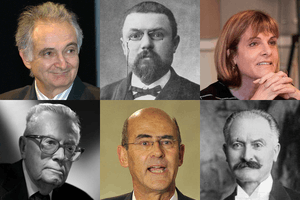Corps des mines
The Corps des mines is the foremost technical Grand Corps of the French State (grands corps de l'Etat). It is composed of the Mine State engineers. The Corps is attached to the French ministry of Economy and industry. Its purpose is to entice French students in mathematics and physics to serve the government and train them for executive careers in France.

Members are educated at the École nationale supérieure des mines de Paris, also known as Mines ParisTech. Each year, the Corps recruits between 10 and 20 members. Most of them are alumni from École polytechnique who are then known as X-Mines, and rank usually among the top 10 students of École Polytechnique; others come from École normale supérieure (ENS), Télécom ParisTech (former ENST) or the regular curriculum of the École nationale supérieure des mines de Paris. Upon graduation, Corps des Mines engineers hold executive positions in the French administration.
Corps des Mines engineers tend to hold top executive positions in France's major industrial companies in the course of their career.
Being admitted to the Corps des Mines program is considered a significant fast-track for executive careers in France.
Missions
Corps des Mines engineers contribute to the conception, implementation and evaluation of public policies in the fields of:
- industry and economy
- energy and natural resources
- information and communication technologies
- environment sustainability, industrial safety and public health
- research, innovation and new technologies
- land use planning and transportation
- standardization and metrology
- banking, insurance and financial services[1]
Corps des Mines engineers typically hold high-level technical or executive positions in various ministries or international organizations. After serving in the administration, part of the Corps des Mines engineers will transition to the private sector, where they hold top executive positions in large industrial companies.[2][3]
Recruitment and training
Corps des Mines engineers are recruited among the top students from École polytechnique, École normale supérieure, École nationale supérieure des mines de Paris and Télécom ParisTech[4]. About twenty engineers enroll every year. During the course of their training, the Corps des Mines engineers have to complete two one-year positions in private companies (one in France and one abroad), followed by a one-year training in public administration, hosted at École nationale supérieure des mines de Paris.
The main aim of the training is to provide theoretical and practical knowledge about how companies operate, together with a sound understanding of government responsibilities in the technical and economic fields.
Former Corps des Mines members
The following are alumni of the school:
Historical
- Maurice Allais, 1988 Nobel Memorial Prize in Economic Sciences
- Charles de Freycinet, prime minister of France at the end of the 19th century
- Henri Poincaré, Nineteenth century mathematician and scientist.
- Conrad Schlumberger, founder with his brother Marcel of the Société de Prospection Electrique, that became later Schlumberger Limited
Current
- Jacques Aschenbroich, CEO of Valeo[5]
- Jean-Louis Beffa, CEO of Saint-Gobain
- Jacques Biot, former president of École Polytechnique[6]
- Jean-Laurent Bonnafé, CEO of BNP Paribas
- Patrice Caine, CEO of Thales Group
- Jean-Pierre Clamadieu, CEO of Solvay, Chairman of Rhodia
- Thierry Desmarest, former CEO of Total
- Jean-Martin Folz, former CEO of PSA Peugeot Citroën
- Noël Forgeard, former CEO of Airbus and EADS
- Carlos Ghosn, former CEO of Renault-Nissan-Mitsubishi
- Isabelle Kocher, former CEO of Engie
- Anne Lauvergeon, former CEO of Areva[7]
- Jean-Bernard Lévy, CEO of Électricité de France
- Francis Mer, former CEO of Usinor and former Minister of Finances
- Luc Oursel, CEO of Areva
- Patrick Pouyanné, CEO of Total
- Pierre Pringuet, former CEO of Pernod Ricard[8]
- Patrick Fragman, CEO of Westinghouse Electric Company
- Denis Ranque, Chairman of Airbus, former CEO of Thales Group
- Jean Syrota, former CEO of Cogema
- Philippe Varin, CEO of Areva, former CEO of PSA Peugeot Citroën
References
- "Légifrance".
- "Comment les ingénieurs des Mines ont pris le pouvoir". Nouvel Obs. Retrieved May 7, 2015.
- "Une haute fonction publique privée à la francaise". Multinationales.org.
- "Senior civil servants trained in MINES ParisTech - MINES PARISTECH". www.mines-paristech.eu. Retrieved 2020-03-06.
- Le Point. "Jacques Aschenbroich star discrète du salon de l'auto". Retrieved October 4, 2018.
- "Jacques Nicolas BIOT (né en 1952)". Les Annales des Mines. Retrieved November 1, 2016.
- "Malgré les affaires, Anne Lauvergeon reste incontournable". Challenges. Retrieved November 2, 2018.
- Abescat, Bruno. "Pierre Pringuet, patron sortant de Pernod Ricard, maître distillateur d'influence". L'Expess.